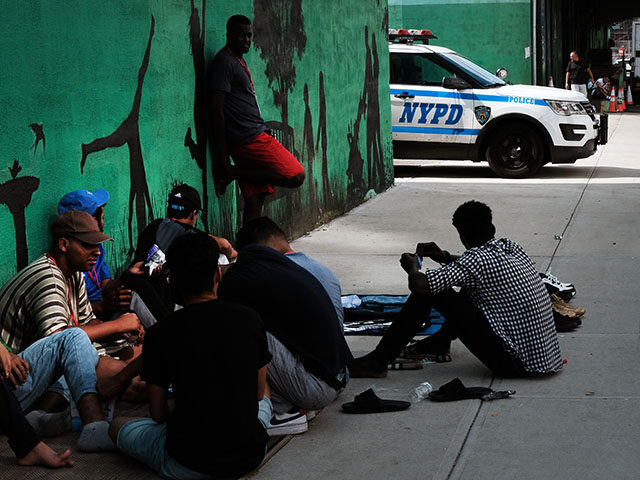Report: NYC’s Low-Income Neighborhoods Overwhelmed by Migrant Shelters
 Spencer Platt/Getty Images
Spencer Platt/Getty Images
Low-income New Yorkers are sounding the alarm about Mayor Eric Adams (D) placing the majority of migrant shelters in their already-impoverished neighborhoods and sucking up resources meant for struggling Americans.
A staggering 193 government-run migrant shelters are operating in the Big Apple, but none of them are located in the top five zip codes by median income, the New York Post confirmed in a recent report.
WATCH — Mayor Eric Adams Floats Giving NYC Lifeguard Jobs to Migrants Because They’re “Excellent Swimmers”:
NYC Mayor's OfficeWhile Tribeca, Battery Park City, the Financial District, and other parts of Lower Manhattan are completely insulated from the sprawling migrant camps and hotels, Long Island City — a neighborhood in the NYC borough of Queens, not to be confused with the suburbs on Long Island — holds 23 of them.
With 12 percent of the city’s migrant shelters stuffed into just one neighborhood, native residents are calling it unfair.
“The city dropped a bomb on us,” said Danny Beauford, a resident of the Queensbridge Houses public housing project in Long Island City. “The [migrants] are taking over. They’re taking over all the parking with their 8,000 scooters. They’re disrespectful — peeing in front of everybody. We do that one time, and we’re going to jail for a long time.”
WATCH — ICE Official: Sanctuary Policies Put Dangerous People in Immigrant Communities, “We Have to Go Out” Constantly:
He also told the Post that the migrants are taking from the food banks and causing long lines to pick up supplies from local pantries and welfare checks.
“People from the projects don’t even get food,” Beauford, 36, said. “[The migrants] come early and tie their little carts up to a gate to hold their spot; then people from the projects show up and are like ‘whose carts are these?’”
According to the Post, “nearly two dozen shelters are clustered around two public housing projects” in Long Island City. The other large development for poor Long Island City residents is Ravenswood Houses.
Beauford is not the only disgruntled resident of Queensbridge, which is the largest housing project on the continent.
“Why are y’all sending them here?” wondered Shawarn Shields, another one of the 7,000 residents. “Send them to Fifth Avenue! Send them to Park Avenue, but they won’t do that.”
WATCH — NYPD Chief of Patrol: We’re Seeing “Uptick” in Migrant Crime, Trends Getting “Bigger”:
“Why are you sending where everyone is already living check to check?” Shields, 56, added. “They ain’t living check to check in Manhattan.”
Councilwoman Julie Won (D), who represents the neighborhood, blamed the long lines at food banks on city-contracted vendors delivering “rotten” and “inedible” food, but acknowledged that resources are being stretched too thin in order to accommodate migrants in her low-income district.
“These shelters are being placed in the poorest part of communities,” Won told the Post. “[The Adams administration] needs to spread them out, so you’re not hurting communities – especially low-income communities.”
This echoed an earlier statement she made to the Queens Daily Eagle in April, where she also mentioned the connection between longer food bank lines and the migrant influx:
They should be evenly distributed, and that’s what the mayor says all the time – equal distribution. Clearly the data shows that that is not how this has been distributed at all.
As you can tell by the number of shelters that I have in my district, those are all hotels that are our budget hotels that were built with this purpose, and they were able to do it willy-nilly without any community consent.
I think they’re just scrambling to open up shelters anywhere they could get a contract without really thinking about how it’s going to impact communities or how you’re going to make it equitable, how you’re going to resource these communities, if you’re going to overburden them. Nor are they doing anything to fix it.
I haven’t received a dime from the mayor for any of these migrant shelters. The mayor [proposed to] cut funding from food pantries. My lines at Queensbridge Houses, and Ravenswood houses for food…are getting longer, not shorter.
The area’s public schools are also struggling to keep up with the wave of migrant children, who often do not speak English and are far behind their peers, but Councilwoman Won told the Post that requests to City Hall for more resources are routinely ignored.
Councilwoman Joann Ariola (R), who also represents a district in Queens, blamed President Joe Biden’s administration for this migrant overload mess.
“The illegal migrant crisis should have never reached this point where we are stuffing people into any space we can,” she told the outlet. “This is a result of massive mismanagement at the federal level, and now working-class people in Queens and Manhattan are shouldering the burden.”
City Hall spokesperson Liz Garcia responded to the concerns by painting the Adams administration’s migrant plan as successful.
“As we continue to try to find safe, viable sites across all five boroughs, we are grateful for every community that has stepped up and welcomed temporary emergency sites,” she told the Post.
“And it is clear that our efforts are working, as we have already helped more than 65 percent of asylum seekers who have come into our care take the next steps in their journeys and move out of our shelter system as they seek to be self-sufficient.”
Source link

